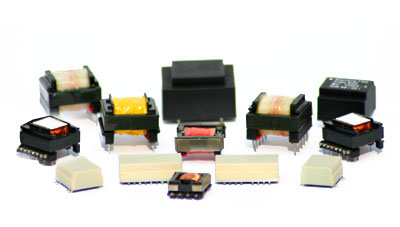Converters

Voltage Converter
A voltage converter changes the voltage of an electrical power source and is usually combined with other components to create a power supply. The term "voltage converter" is sometimes used as a generic term for a power supply. A voltage converter or a power supply may be called a "transformer" even if it does not contain an actual transformer as the term is used in electronics.A common use of the term voltage converter is for a device that allows appliances made for the voltage of the common electrical outlets of one geographical region for the outlets of another area. Most single phase alternating current electrical outlets in the world have a voltage range of 210 to 230 volts or a range of 110 to 120 volts. Converters usually can only double the voltage or halve the voltage but some are set up to do both.
There are a number of methods for converting voltage. For Alternating current (AC) a transformer can be used to decrease or increase the voltage. The common power supplies for small electronics usually have a transformer that drops the voltage down to relatively small voltage ranging from 4.5 to 12 volts, a full-wave rectifier to convert the AC to a pulsed Direct Current and some additional components to flatten the wave. Converting a low DC voltage to a high DC voltage requires conversion to AC, the use of a transformer to increase the voltage and then a rectifier and conditioning circuit to convert it back to DC. Going through an AC step can also be used to drop voltage. There are two types of Voltage Converters Step UP and Step Down. Step Up converts from 110 volts to 230 volts and Step down will convert from 230 volts to 110 volts. Most voltage converters convert both ways.
buck-boost converter
Two different topologies are called buck-boost converter.
1. ) The inverting topology - The output voltage is of the opposite polarity as the input
2. ) A Buck (step-down) converter followed by a Boost (step-up) converter - The output voltage is of the same polarity as the input, and can be lower or higher than the input
Here describes the Inverting topology.
The buck-boost converter is a type of DC-DC converter that has an output voltage magnitude that is either greater than or less than th input voltage magnitude. It is a switch mode power supply with a similar circuit topology to the boost converter and the buck converter. The output voltage is adjustable based on the duty cycle of the switching transistor. One possible drawback of this converter is that the switch does not have a terminal at ground; this complicates the driving circuitry. Also, the polarity of the output voltage is opposite the input voltage. Neither drawback is of any consequence if the power source is isolated from the load circuit (if, for example, the source is a battery) as the source and diode can simply be reversed and the switch moved to the ground side.
Flyback converter
The Flyback converter is a DC to DC converter with a galvanic isolation between the input and the output(s). More precisely, the flyback converter is a buck-boost converter with the inductor split to form a transformer, so that the voltage ratios are multiplied with an additional advantage of isolation. When driving for example a plasma lamp or a voltage multiplier the rectifying diode of the Buck-Boost converter is left out and the device is called a flyback transformer. Due to intrinsic limitations, this converter is only used in low power applications (up to about 250 W).
Operation.
The flyback converter is an isolated power converter, therefore the isolation of the control circuit is also needed. The two prevailing control schemes are voltage mode control and current mode control. Both require a signal related to the output voltage. There are two common ways to generate this voltage. The first is to use an optocoupler on the secondary circuitry to send a signal to the controller. The second is to wind a separate winding on the coil and rely on the cross regulation of the design.
The flyback is often used in multiple output circuits because of the cost-effective regulation of multiple outputs. By holding one output at a constant voltage, and transferring current, whichever output is lowest (relative to the turns ratio of the transformer) will receive the most current, bringing it back up in voltage. When an output is too high, it receives less current, and the loading brings it back down.
Applications
1. Low-power switch-mode power supplies (cell phone charger, standby power supply in PCs, main PC supplies < 250 W)2. High voltage supply for the CRT in TVs and monitors (the flyback converter is often combined with the horizontal deflection drive).
3. High voltage generation, e.g. for Xenon flash lamps, lasers, copiers etc.
4. The ignition system in Spark-Ignition engines is also a flyback converter, the ignition coil being the transformer and the contact breaker forming the switch element.
5. Isolated gate driver.
6. Low cost multiple-output power supplies.
Push-pull converter
A push-pull converter is a type of DC to DC converter that uses a transformer to step the voltage of a DC power supply. Since it uses a transformer, its ratio is arbitrary but fixed. The primary advantages of push-pull converters are their simplicity and ability to scale up to high power throughput, earning them a place in industrial DC power applications. The push-pull converter is similar to the flyback converter and especially the forward converter.
